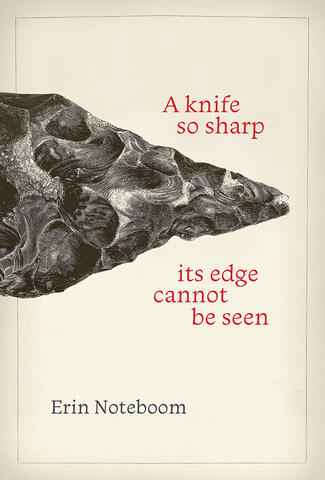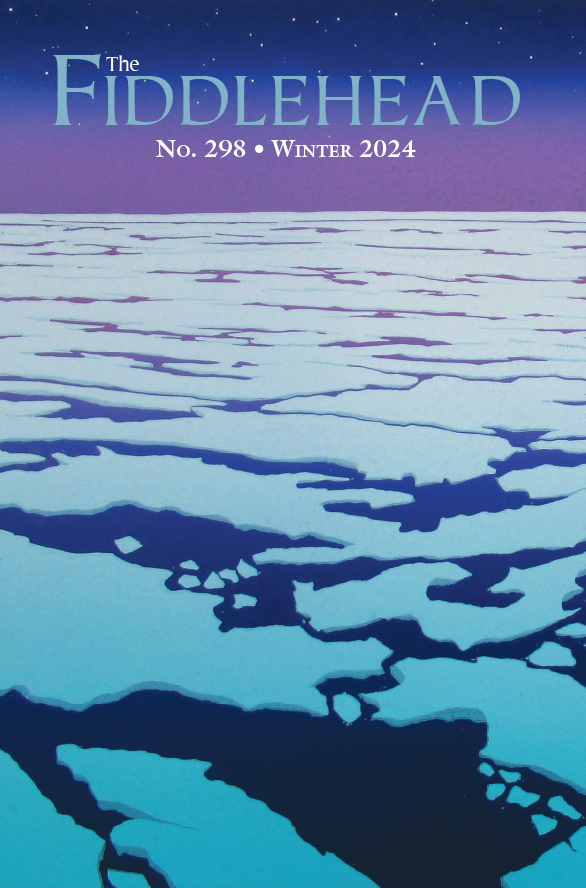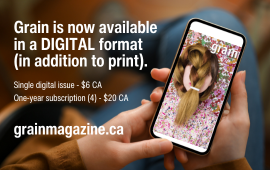
In A knife so sharp its edge cannot be seen, Erin Noteboom merges her background as a particle physicist with poetry. She excavates intangible and indescribable moments from scientific experiments to blur lines between worlds that otherwise seem separate.
“Ghost Ring,” the poem that opens the first section of the book (“Skiagraphs”), begins with a long citation of a scientist’s first experience with X-rays. Now a common procedure that most of us have gone through, Noteboom hones in on how at its first discovery, the scientist proclaimed a line that would not be out of place in a poem: “I have seen my death.” This form of epigraph is poetic in its own way; Noteboom sets up the context for the poem, which then lyrically delves into the situation from the perspective of the scientist’s wife, upon whom this X-ray was first done. “In the unveiled negative, / my flesh is half-life, / my bones less solid than the ghost / of our ring” (12), she writes. Offering alternate versions of history through a feminized lens is something many poets do in their practices as a way of redressing historical accounts, but this poet’s manner of offering merges the historical and poetic, and does not leave the historical to a footnote or endnote.
Her interest in women’s history carries on to the series of poems about Marie Curie and her life. In reference to the dangers of radiation that Curie did not know about during her research, Noteboom writes: “There is no way for her to know / that her light will soon paint gunsights / and watch dials. That it is ticking through her body, / his body, faster than time” (16). Continuing the theme of science-created catastrophes, the poems explore nuclear testing and radioactive sites, how “what haunts it is both vast / and subtle” (25).
Another major theme Noteboom skillfully blends into these science-focused poems is that which is sacred or holy. The book’s first poem has the lines: “We know a sacred place by how it listens, / answers.” (1). As we enter the second section of the book, Noteboom writes, “I remember perfect apricots, / favoured by the radiance of God” (31). In this poem, titled, “Imprisoned, al Haytham makes notes on the nature of light,” it is especially refreshing to see her not eschew the holy or sacred amidst the scientific, and instead write the two as inextricably linked. In “The Common Swift,” she writes how “the equation of science . . . is only / half a turn from love” (35), which in some ways sums up a lot of the directions the book takes.
After two fairly intense sections about scientific tragedy in particular, Noteboom eases the pace of the book with a third section of ghazals and a fourth of poems that often begin with “untitled.” These poems offer groundedness through more colloquial language, such as the lines, “How sick buries us — / it ranks of pills, its stupid rituals. / It slicks our skin and twists our smell, / and we are mammals after all —” (57). The balance offered between scientific and our everyday makes the more technical information easier to absorb.
In the second half of the book, Noteboom poses questions such as “”What is asked of us?”, “What do we hope for?” and “What remains?” to name a few. She answers these in fragments: to the question “What calls? What answers?” she writes “The moon calls and the salt / answers. The knife calls / and the sun answers” (65). These poems seem to call back to her line about a sacred place being sacred by its ability to offer answers. Here, the poems may not follow scientific logic but nonetheless offer answers that are felt and understood in other ways.
Curie appears again in the second last poem of the collection, this time focusing on her after-death, on how her lab was torn down and rebuilt, how her notebooks have to be kept in lead because of the radiation they emit. Noteboom approaches Curie with nuance, writing: “I am not a saint or a martyr” (73). In this way, she emphasizes the ability of poetry to offer multiple perspectives. There are no hard facts or strict lines in this work. To circle back to the title, it is the sharpness of the edge that makes it impossible to see at all.
The book closes with a list poem of instructions on “How to write at the end of the world.” The poet proclaims,
The list becomes like a prayer, an offering in the way Noteboom’s poems continuously feel like offerings throughout the collection. A knife so sharp its edge cannot be seen has the ability to linger.












